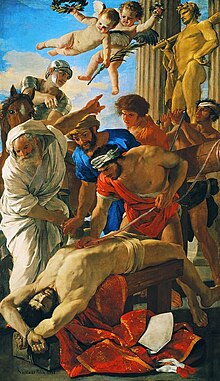Erasmus of Formia
Fort St. Elmo (Malta) |
|---|
Erasmus of Formia, also known as Saint Elmo (died c. 303), was a
Documentation of his life
The Acts of Saint Elmo were partly compiled from legends that confuse him with a Syrian bishop Erasmus of Antioch. Jacobus de Voragine in the Golden Legend credited him as a bishop at Formia over all the Italian Campania, as a hermit on Mount Lebanon, and a martyr in the Diocletianic Persecution. There appears to be no historical basis for his passion.[4]
Account of life and martyrdom
Erasmus was Bishop of Formia, Italy. During the persecution against Christians under the emperors Diocletian (284–305) and Maximian Hercules (286–305), he left his diocese and went to Mount Libanus, where he hid for seven years. However, an angel is said to have appeared to him, and counseled him to return to his city.[5]
On the way, he encountered some soldiers who questioned him. Erasmus admitted that he was a Christian and they brought him to trial at Antioch before the emperor Diocletian. After suffering terrible tortures, he was bound with chains and thrown into prison, but an angel appeared and helped him escape.[5]
He passed through
These actions angered the emperor, who had Erasmus enclosed in a barrel full of protruding spikes and rolled down a hill. An angel healed him from these wounds.

When he was recaptured, he was brought before the emperor and beaten and whipped, then coated with pitch and set alight (as Christians had been in Nero's games), and still he survived. Thrown into prison with the intention of letting him die of starvation, Erasmus managed to escape.

He was recaptured and tortured in the Roman province of Illyricum, after boldly preaching and converting numerous pagans to Christianity. Finally, according to this version of his death, his abdomen was slit open and his intestines wound around a windlass. This version may have developed from interpreting an icon that showed him with a windlass, signifying his patronage of sailors.[6]
Veneration and patronage
Erasmus may have become the
There is an altar to Erasmus in the north transept of St. Peter's Basilica.[9] A copy of Nicolas Poussin's Martyrdom of St Erasmus serves as the altarpiece.[6]
The skull of St. Erasmus, venerated as a relic, is purported to be in St. Peter's Church in Munich, Germany.[10]
Besides his patronage of
Gallery

-
Meeting of Saint Erasmus andAlbert of Mainz, who commissioned the painting, as the model for St. Erasmus.
-
The belfry of the Cathedral of St. Erasmus in Gaeta
-
The martyrdom of Saint Elmo, by an unknown painter from the Netherlands, 1474
-
Martyrdom of Saint Erasmus
See also
- St. Elmo Hall, a name for some chapter houses of Delta Phi fraternity
- St. Elmo's fire, a meteorological phenomenon named after the saint
- List of early Christian saints
- Saint Erasmus of Formia, patron saint archive
- Blessed Peter González, patron of Spanish and Portuguese mariners is also invoked as "San Telmo" or "San Elmo".
References
- ISBN 88-209-7210-7
- ^ Saint of the Day, June 2: Erasmus of Formia SaintPatrickDC.org. Retrieved 2012-03-07.
- ^ "Saint Erasmus" Saints.SQPN.com. Retrieved 2012-03-07.
- ISBN 9780814629703
- ^ a b c "Hieromartyr Erasmus the Bishop of Formia in Campania", Orthodox Church in America
- ^ a b ""Poussin, the martyrdom of St. Erasmus", Department of Art History and Architecture, Columbia University". Archived from the original on 2013-12-12. Retrieved 2013-04-06.
- ISBN 978-1-4081-3131-2.
- ^ St. Erasmus (St. Elmo) Catholic Online. Retrieved 2012-03-07.
- ^ Altar of St. Erasmus - St. Peter's Basilica
- ^ Edwards, Elisabeth (2022-09-29). "The Bejeweled Skeleton of Saint Munditia is on Public Display". thevintagenews. Retrieved 2023-10-05.
External links
- The Golden Legend (Saint Erasmus) – e-text adapted from Wynken de Worde's edition of 1527.
- Saint of the Day, June 2: Erasmus of Formia at SaintPatrickDC.org




